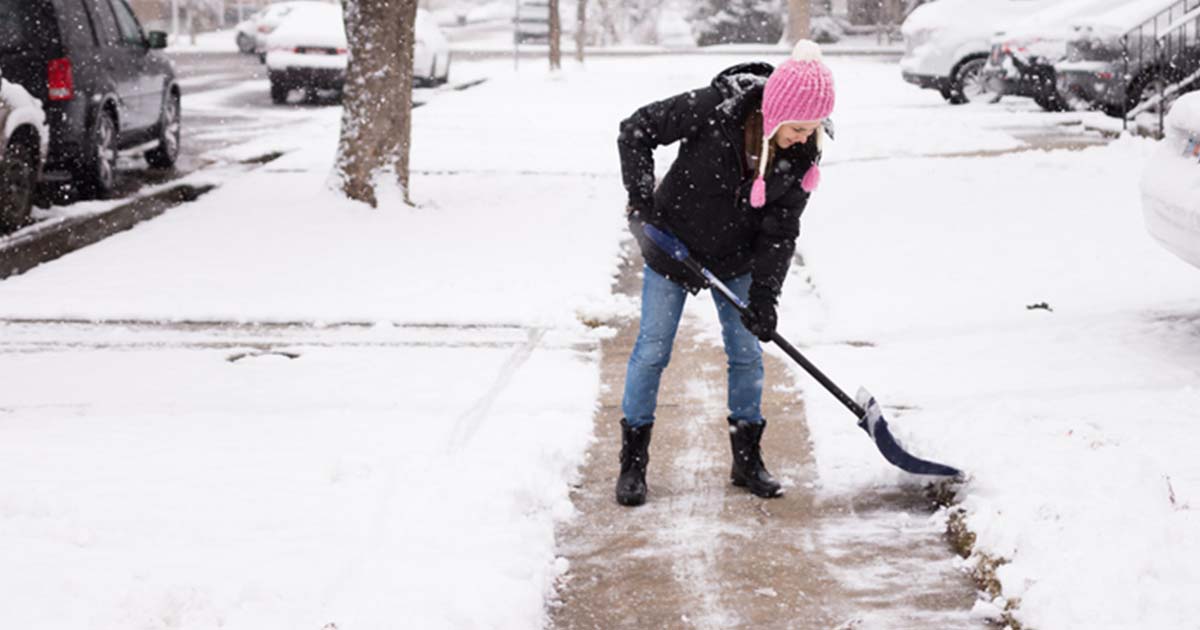Safely Cleaning Your Sidewalk

Shoveling the snow is one of the downfalls of a winter wonderland but it does not need to be the dreaded chore many people think it is. When done safely, cleaning your sidewalk can even be healthy exercise.
According to OHS Canada, “it works both your upper and lower body, and these sorts of activities done regularly can reduce your risk for heart disease and premature death. In lab testing, snow shoveling was equivalent to vigorous physical activity, like running on a treadmill.”
Shoveling snow can be a health risk for some people
But you do need to be careful about safety, especially if you have a health condition like heart disease or are inactive. Cold weather complicates shoveling because it makes arteries constrict when they need to open so more blood can flow to the heart and muscles. This can mean higher blood pressure, poor blood flow, more work for the heart, and a higher risk of heart attack and stroke.
Heart conditions are not the only shoveling-related injures to send people to the hospital. In the U.S., the average of 11,500 injuries consists mainly of lower back injuries and muscle tears and strains. Make sure to warm up before you start shoveling by walking for 5-10 minutes and do some stretches.
Choose the right tool for the job
Using the right kind of shovel will make cleaning your sidewalk much easier and reduce the risk of injury.
- Home Depot says that “ snow shovels with ergonomic handles can reduce strain on your back and promote better hand positioning and encourage better foot placement to bring greater leverage while shoveling.”
- Snow pushers are broad with curved blades and are used to plow, not shovel. they are meant for removing small amounts of snow or slush from large areas. If you are using a snow pusher, tilt it to dump the snow out instead of lifting it.
- Choose a snow shovel that weighs three pounds or less.
- A smaller blade means moving less snow at once and a lower risk of injury.
- The handle should reach chest height.
Ergonomic shoveling
Ergonomics is not just for your office chair and working with your body instead of against it makes shoveling easier.
- Keep your feet hip-width apart and your front foot close to the shovel with your weight on the front foot.
- Help push the snow with your legs.
- According to Ergo Consulting, “When lifting, breathe in, bend knees (not back), tighten stomach muscles, lift with your legs while shifting your body weight to back foot. Breath out while throwing snow.”
- Keep the load of snow close to your body.
- Turn your feet in the direction you want to throw the snow and do not twist.
Shoveling safety tips
The Canadian Centre for Occupational Health and Safety (CCOHS) has some tips for shoveling the sidewalk safely.
- You should not shovel more than 15 scoops a minute.
- You should not shovel at this rate for longer than 15 minutes and should take 15-minute breaks.
- When shoveling 15 scoops per minute, the weight of the snow and shovel should not be more than 15 pounds.
References:
https://ergoconsulting.ca/blog/safe-snow-shoveling/
https://www.homedepot.com/c/ah/how-to-shovel-snow/9ba683603be9fa5395fab9011324d9c7
https://www.marthastewart.com/2224254/how-effectively-safely-shovel-snow
https://www.ohscanada.com/snow-shovelling-healthy-exercise-deadly-activity/



.jpg?300x300)